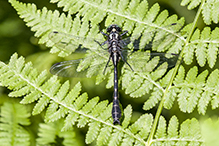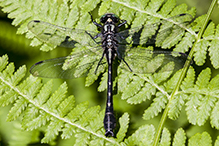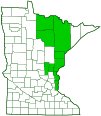green-faced clubtail
(Hylogomphus viridifrons)
Conservation • Description • Habitat • Ecology • Distribution • Taxonomy
|
|
|||||||||||||
Description |
Green-faced clubtail is an early season, medium-sized clubtail. While it is more common in the northeast than in Minnesota, it is uncommon and considered rare over most of its range. The upper (dorsal) side of the thorax is pale grayish-green on top with black markings including a broad central (middorsal) stripe, two lateral stripes, and a shoulder stripe. The side of the thorax is grayish-green with an incomplete first (anterior) stripe that arches around to join the shoulder stripe. There is no middle stripe found on most other clubtails. The abdomen is slender and black with yellow markings. Abdominal segments 1 through 7 have small yellow dorsal spots and larger yellow lateral spots. On the male the dorsal spots are tiny. On the female they are larger but still small. Segments 8 through 10 are unmarked on top. Segment 9 is shorter than segment 8. Segments 8, 9, and 10 are expanded into a noticeable “club”. The head is small. The large compound eyes are green. They do not meet at the top of the head. The area behind the compound eyes at the top of the head (occiput) is slightly convex. The face is grayish-green with a single horizontal stripe on the lower part of the face above the upper lip (labrum) that is divided in the middle horizontally. The legs are black. The wings are clear except for dark stigmas. The wing triangle, a section of intersecting veins about 20% of the way from the base to the wingtip, is about the same size in the forewing and the hindwing. The female is similar but may have yellowish markings, especially on the face. |
Size |
Total length: 1¾″ |
Similar Species |
Mustached clubtail (Hylogomphus adelphus) has two black horizontal lines on the face and an inverted black triangle dividing the labrum. The lower line is not divided in the middle. |
Habitat |
Rapid medium streams and rivers with gravel, silt, sand, and rocks |
Ecology |
Season |
Mid-may to mid-July |
Behavior |
Males are most active in late afternoon, especially under cloud cover. |
Life Cycle |
The female does not have an ovipositor. She lays her eggs by washing them off in fast-flowing water. The eggs flow into slow water where the young (naiads) develop. |
Naiad Food |
|
Adult Food |
|
Distribution |
||
|
Sources Biodiversity occurrence data published by: Minnesota Biodiversity Atlas (accessed through the Minnesota Biodiversity Atlas Portal, bellatlas.umn.edu, 7/31/2025). Haarstad, J. 1997. The dragonflies of selected eastern Minnesota rivers. Report submitted to the Minnesota Department of Natural Resources. Unpaged. Steffens, W. P., and W. A. Smith. 1999. Status survey for special concern and endangered dragonflies of Minnesota: population status, inventory and monitoring recommendations. Final report submitted to the Natural Heritage and Nongame Research Program, Minnesota Department of Natural Resources. 54 pp. |
|
| 7/31/2025 | ||
Occurrence |
||
Rare |
||
Taxonomy |
|
Order |
Odonata (Dragonflies and Damselflies) |
Suborder |
|
Superfamily |
Gomphoidea |
Family |
Gomphidae (clubtails) |
Genus |
Hylogomphus |
Superfamily Genus |
|
Subordinate Taxa |
|
|
|
Synonyms |
|
Gomphus viridifrons |
|
Common Names |
|
green-faced clubtail |
|
Glossary
Labrum
The upper part of the mouth, sometimes considered the lower part of the face, corresponding to the upper lip, on an insect or crustacean.
Naiad
The aquatic larval form (nymph) of a dragonfly, mayfly, or stonefly.
Occiput
The back of the head. In Odonata, Megaloptera, and Neuroptera, the upper part of the head behind the eyes.
Stigma
In plants, the portion of the female part of the flower that is receptive to pollen. In Lepidoptera, an area of specialized scent scales on the forewing of some skippers, hairstreaks, and moths. In other insects, a thickened, dark, or opaque cell on the leading edge of the wing.
Visitor Photos |
||
Share your photo of this insect. |
||
This button not working for you? |
||
|
||
|
||
MinnesotaSeasons.com Photos |
||
 |
||
 |
 |

Slideshows |
|

Visitor Videos |
||
Share your video of this insect. |
||
This button not working for you? |
||
|
Other Videos |
||
|

Visitor Sightings |
||
Report a sighting of this insect. |
||
This button not working for you? |
||
|
|
MinnesotaSeasons.com Sightings |
||

Created: 11/3/2015 Last Updated: © MinnesotaSeasons.com. All rights reserved. |
